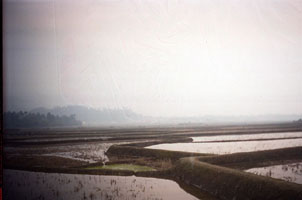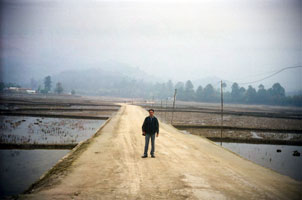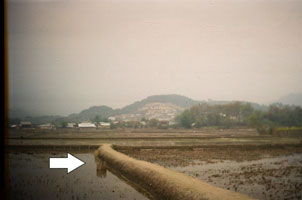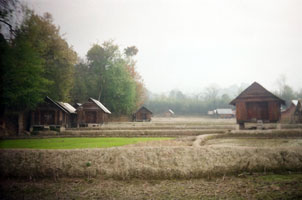Traditional Practices in Agriculture among the Apatanis of Arunachal Pradesh
| Introduction | The Practice of Wet-rice cultivation |
| Methodology | The Practice of Fish Cultivation |
| The People and the location | Village organisation in relation to agriculture system |
| Conclusion |
Abstract
The Apatanis of Arunachal Pradesh are shown to have possessed a highly evolved traditional technique of rice cultivation besides being quite rich in ethno-botanical knowledge .
Introduction
Traditional societies have always intimately interacted with ‘mother nature’, and therefore they have accumulated pragmatic knowledge in their day-to-day life. There is an inherent realization in traditional societies that man and nature form part of an inseparable unit and therefore should live in partnership with each other. This ecocentric as well as reverential attitude of the traditional societies is widely reflected in their attitudes towards plants, animals, rivers, earth and their day-to-day activities (Vatsayan, 1993). In this regard the agricultural system of traditional societies offers one of the ways to decipher their technologies for conserving biodiversity through traditional ecological knowledge. All over the world the agricultural practices differ from shifting cultivation to wet rice cultivation and from one population group to the other. One such agricultural practice called integrated wet rice cum fish cultivation can be found in several parts of Indonesia, Japan, Philippines, Vietnam, Malaysia, Thailand, Myanmar, China and India. This type of agricultural system consists of various waste recycling technique as well as utilization of ecological setup. The system is often energy efficient with greater economic output as well as beneficial for the ecological condition.
The present paper highlights the traditional wet rice-cum-fish cultivation carried out by the Apatanis of Arunachal Pradesh. It also describes the practice as a measure of natural resource management for sustainable livelihood and improved quality of life. In this paper the attempts are made to see the social background under which the Apatanis maintains their cohesive nature, which differentiates them from the neighbouring tribes. The current changes going on in this knowledge system as a result of the introduction of modern technology and changing social system have also been visualized.
Methodology
Standard anthropological methods and techniques have been applied to generate the necessary data and to document the agricultural practices of the Apatanis. The documentation was carried out in the month of April 2007 at Hari and Salaya village which are almost six km apart from the Ziro township, the headquarter of Lower Subansiri district, Arunachal Pradesh. Twenty-one community members were interviewed during the fieldwork following a convenience sampling technique and it was supplemented by frequent visits afterwards.
The People and the location
India has a total of 427 tribal communities, out of which more than 130 communities live in Northeast India with a higher concentration in Arunachal Pradesh. The Apatani is one of the twenty-six major tribal communities of Arunachal Pradesh concentrated in Ziro valley of Lower Subansiri district. The valley is often called Apatani platue. The plateau is located at around 1500 meters above sea level and is situated between 26°55' – 28°21' N and 92°40'-94°21' E. No written records have been found regarding the historical origin of Apatanis, however there are some legendary thoughts that they came to reside this valley after crossing the Subansiri river from North. Recent findings of Neolithic celts by Archaeological Survey of India (1992) at Parsiparlo and Raga circle as well as remains in the Tage valley demonstrates that Apatanis have migrated from North. Apatanis are the followers of their traditional Donyi-Polo religion, believing that the sun (Donyi) and moon (Polo) are the supreme Gods who bless the community. They also believe in various other deities. They belong to the Indo-mongoloid racial stalk and trace their descent through the legendary Abotani, created by one of their deity named Hilo. Their language belongs to Tibeto-Burman linguistic family. Rice is their staple food and they prefer mithun (Bos frontalis), chicken and cow for their meat.
The decennial population figures (since 1961) of the Apatanis are presented in Table 1.
Table 1: Decennial population figures (since 1961) of the Apatanis.
|
Year |
Population |
% to state |
|
|
Apatani |
Arunachal Pradesh |
||
|
1961 |
10,793 |
3,36,588 |
3.21 |
|
1971 |
12,888 |
4,68,511 |
2.75 |
|
1981 |
16,580 |
6,31,839 |
2.62 |
|
1991 |
22,526 |
8,64,558 |
2.61 |
|
2001 |
24,650 |
10,91,117 |
2.26 |
Source: Census of India, Part IX-B, Government of India.
The Practice of Wet-rice cultivation
The Apatanis use the most evolved form of wet rice cultivation in Northeast India. They have a proverb ‘Tani he jebi dani’, which means they primarily depend on wet rice cultivation. Their land tenure system is well documented and it can be categorized into individual land, clan land and community land (otherwise called village land). They have developed their independent technique of rearing fish in their paddy field to meet the requirement of rice as well as fish and also to enhance the economic output. Pictorial diagram of the agricultural fields are depicted in figure 1.

Figure 1 (a): Wet rice fields with slopes

Figure 1(b): Author on the road connecting wet and dry rice field

Figure 1(c): Wet rice fields showing hubur

Figure 1(d): Dry rice field
In the agricultural system mainly human labour is used, which is a very primitive form of tillage system. Irrespective of sex, they start their work early in the morning and continue till evening without the help of domesticated cattle or any other modern system. Here it should be noted that Apatanis have a high bride price (equated with Bos frontalis), which is often found to be compensated by the continued labour of the women folk in the rice fields. Therefore up keeping of the terrace fields take up most of the energy of the women folks. However supply of Bos frontalis in a household through bride price also adds to the animal husbandry of a family. The Apatanis have developed a multipurpose water management system. Here they are able to integrate land; water as well as farming system and thereby facilitate soil and water conservation. The water from every streams and rivulets that originate from the forests as well as foothills is trapped into a large channel and then diverted to various secondary channels from where every field plots get adequate water. Ground water is also diverted to the fields after accumulating it into a pond. Thus water that accumulates from all the adjoining slopes easily flows down the rice fields. The networks of channels are regulated by wooden sluice gates. By opening and closing these gates, the water is regulated so that the desired field is irrigated. Currently one finds in some cases , for better regulation of water, the wooden sluice gates are replaced by iron sluice gates. To drain off water from one terrace to another terrace, hollow bamboo or wooden pipes (hubur) are placed in each plot. These bamboo pipes are also covered with bamboo meshes. At least 10 to 15 cm of water is maintained in each plot by adjusting the height of the outlet. Spraying of organic manure such as animal excreta as well as kitchen wastes is regularly done in these plots. A gentle slope is maintained in each rice field to maintain the required level of water. If water overflows in one plot of field then it passes to the next field, which is located at a lower level. Generally every village is situated at a higher level than the agricultural field. Therefore every organic waste materials as well as poultry refuse generated in the village is drained into agricultural fields through the irrigation channels. This not only adds valuable fertilizers to the field but also prevents pollution of environment. The accumulated husk from the previous year is also used as fertilizer. Thus they do not have to use any chemical fertilizers in their fields. However, now a days the use of insecticides as well as pesticides in minute quantities is also found among them. During winter and spring season also they (specially the women folk) transfer organic waste from the village to the rice field with the help of baskets. Their rice fields can be divided into two varieties, one is wet and the other is dry. The wet rice field is always filled up with water whereas the dry field comes into being after every harvest. The wet rice field is situated almost at the centre of the valley, which is served by the water channels, whereas the dry one is situated little far from the main valley and generally filled with rainwater. The wet field is used for cultivating late ripening variety of rice called Emo and the field is generally left untouched for several years with just spraying of little organic manure. The dry field is used for early ripening variety called plare. Before showing of plare the field is ploughed by locally made iron hoe or similar objects. The early varieties are harvested in the early part of July whereas the late varieties are harvested in the month of September-October. Due to the accumulation of nutrients from wash out water as well as compost of organic wastes of the village, the agricultural soil becomes very fertile. Apart from sowing the reported varieties rice, it was found that they very much prefer ‘aino ari’ and ‘alang emo’ (early growing varieties of rice) in their paddy field. There are small plots near the main valley acting like nurseries (miding) where all the rice is sown. Existence of different blocks for different rice varieties is a general practice. Transplantation of rice from these nurseries to the paddy fields takes place in April. Sometimes wet rice cultivation is supplemented by a dry crop Eleusine coracana. Two varieties of E. coracana i.e. early millet (mipya) and late ripening millet (sarte) are also planted next to the elevated partition along the bunds of the rice fields. Apatanis also grow maize and vegetable in their kitchen gardens. In the surrounding hills they also grow different varieties of bamboo as they are fully dependent on bamboo for building their house. The yearlong agricultural activities of the Apatanis have been depicted in Table 2.
Table 2: Agricultural calendar of the Apatanis
|
Month |
Activity |
Persons responsible |
|
January-February |
Preparation of rice beds in nursery and weeding of agricultural land |
Mainly Female folks |
|
March- April |
Land preparation |
Male as well as female folks |
|
April-May |
Transplantation of seedling |
Mainly female folks |
|
July-August |
Harvesting of early variety of rice as well as weeding |
Mainly female folks |
|
September-October |
Harvesting of late ripening rice |
Male as well as female |
|
December-January |
Transfer of waste material to the field |
Mainly female folks |
The Practice of Fish cultivation
Along with rice cultivation the Apatanis also cultivate fish in their rice fields. Rearing of fish is carried out along with paddy cultivation by digging a pit in the middle of the field. It is basically carried out in the wetland. Fish culture in the paddy fields has become an additional source of economic output and serves as an occupation for the unemployed. It is intimately related to their agrarian life. They started fish cultivation in their paddy fields only after India’s independence in 1947. In earlier days the Apatanis used local made gear Tajer, Takhun and Barju in order to catch fish in river. Common carp (Cyprinus carp), leather carp (Cyperinus carpio var. nudus), mirror carp ( Cyprinus carpio var.specularis) and scale carp (Cyprinus carpio var. communis) are some of the varieties of fish, which they culture. The plots utilised for rice-cum-fish culture is mainly based on organic fertilizer with a varieties of animal excreta such as cow dung (si ekha), poultry dropping (paro pai) and wastes of plants such as rice husks (pina), compost fertilizer like decomposed straws (lisi), weeds (tami) and stalks (ankho), waste product of local beer (poi), ashes from household burnt (mubu) and remains of burnt straws (muyu) after the harvest is over. They utilise these domestic waste products to their paddy fields to enhance productivity of the crops, which in turn enhance soil fertility and also act as source of food for the fishes. They transfer the waste material to their paddy fields during the month of December and January when the transplantation for the next season begins.
Village organisation in relation to agriculture system
Apatanis also maintain a very integrated way to regulate the village organisation. Each village has councils called buliyangs made up of one to two male representatives from each clan (halu). With the cooperation from buliyangs as well as the village headman the irrigation system as well as maximum use of water delivery system becomes successful. Other social groups include patang and bini-ajin. Generally a patang is made up of nearly ten members. Bini-ajin is a friendly type of relationship formally develops during the Myokoh festival in March every year. It is the network of relationship developed between different individuals in their age long interaction. The members render their help to each other in each and every crisis situation after being tagged as Bini-ajin. Above all the Apatanis have developed different kinds of informal farmer groups like bogo, aji-linda, biji-linda, solu shiki working as a separate economic unit sometimes offering financial help to the group members. The Dree festival, celebrated from 4th to 7th July every year, is also intimately related to their agriculture and celebrated for the well being of the seasonal crops. The interrelationship between different structures related to their agricultural system is depicted in Figure 2.

Figure2: Wet rice cultivation and Apatani society: interrelationship
But in recent years it is disturbing to find that the youth of the Apatani tribe are showing reluctance to involve themselves in the practice of their traditional agricultural system .. As a result, the burden of farming is gradually shifting to the older folk of the society. More recently increasing number of labour forces are coming from the nearby tribes like the Nyshis, a tribe of shifting cultivators by tradition, which has created an indirect effect on the cohesive nature of the Apatanis, and it can be hypothesized that it may lead to the dilution of their traditional knowledge system.
Conclusion
The Apatanis have not only a highly evolved traditional technique of rice cultivation but also have a highly enriched ethno-botanical knowledge (Kala, 2005). Their immediate dependence on nature has manifested in their traditional culture, religion, local beliefs and folklore. These knowledge systems in comprehending the complexities of age-old survival strategies often against unfriendly environment should not be wasted without the benefit to mankind. There are various other potential indigenous systems prevalent in Northeast India, which provides the opportunity to know the local society’s ingenuity and skill. Sometimes conservation of resources including biodiversity and associated knowledge systems keep the traditional people economically deprived which is not ethical in practice. At this point the main obstacle is to identify such a mixture of inducements that help local communities improve their economic and social conditions and at the same time preserve the environment and the relevant knowledge systems. The Government should encourage the young generation to sustain their traditional knowledge. There is enough scope to learn about the adaptive mechanism of a particular population in the different ecological niche. The transfer of technology from evolved type of society to the other societies could be helpful for future generation. Ramakrisnan (Ramakrishnan et al. 2005) once suggested a ‘hybrid’ technology towards linking conservation with sustainable development. These developments can operate at ecological, social and institutional levels and can be derived from the conventional and formal sciences.
References
- Kala, C.K., 2005. Ethnomedicinal botany of the Apatani in the Eastern Himalayan region of India. Journal of Ethnobiology and Ethnomedicine, 1: 11.
- Ramakrishnan,P.S, R.Boojh, K.G.Saxena, U.M Chandrashekhara, D.Depommier, S.Patnaik, O.P. Toky, A.K.Gangawar and R.Gangawar., 2005. One Sun, Two Worlds: An Ecological Journey. UNESCO and Oxford & IBH, New Delhi. Pp. 286.
- Vatsayan,K., 1993. Prakriti. New Delhi : Indira Gandhi National Centre for the Arts.



